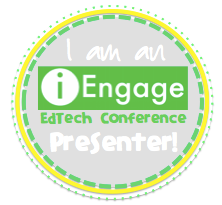 |
| Donalyn Miller alongside my district crew and me! |
- Wild Readers Dedicate Time to Read
- Wild Readers Self-Select Reading Material
- Wild Readers Share Books and Reading with Other Readers
- Wild Readers Have Reading Plans
- Wild Readers Show Preferences

Miller is the perfect example of a wild reader. She states she "reads for a living". As she gives us a glimpse into her life as a reader, Miller explains how she's the happiest when reading. Reading allows her to block out life's demands. She finds "daily solitude within the pages" of her books. Miller describes how she makes it a priority to carve out reading time in her day because it is something that matters to her. An author named John Green was quoted in this chapter saying, "Reading forces you to be quiet in a world that no longer makes a place for that" (2011). I love this quote. It's so true that life is filled with noise. What better way to tune it out with a good book?


Miller provides suggestions to better support students' wild reading habits both at school and at home. She affirms "It is necessary to model, explicitly teach, and reflect on students' development of lifelong, avid (or, as I call them, "wild") reading behaviors to ensure that students remain motivated, engaged readers." Students can become wild readers when they begin to internalize reading habits.
According to Miller, teachers must set a reading foundation in the classroom before kids will internalize reading habits and become wild readers at home. She does this by carving out time in class for independent reading, passing books into her students' hands and discussing with students what they read. She shows her students how reading can enrich their lives, just as it enriches her own life. If students are part of a reading community at school, they begin to live like readers. They have the opportunity to exchange books with peers, share observations and impressions, as well as make book recommendations.
Miller suggests a fresh idea to use at the start of the school year called Status of the Class to support students in sharing about books. It's easy to implement, but is not necessarily used year-round. It's more of a "get reading routines started" type of activity which may be the first four weeks of school or after holiday breaks from school to jump start reading activity.
Miller states, "Students who don't read much or have lost their reading habit over the summer may not read much at first if we don't hold them accountable for their reading immediately." Status of the Class is a form students are required to fill out daily. Students then share their reading *status* with the class by using a "one-sentence, spoiler free summary of what is happening in the book" they are reading.
Generally, if students are given choice in the books they read, time for independent reading and access to wild-reading role models in school, the more likely they will fall in love with reading. If they fall in love reading, they'll most likely find time for it outside of the school day. Miller states, "Beyond racking up reading miles, ensuring that our students read everyday at school provides students opportunities to fall in love with books and develop stamina for reading."
Look below. Have you seen this Why Can't I Skip My 20 Minutes of Reading Tonight graphic before? I'm sure you have. It's an oldie but a goodie. As you already know, our classrooms are filled with a variety of readers, including those falling under the Student A, Student B and Student C columns. Student A readers are most likely those who enjoy reading, while Student B and C readers are just those still needing to discover a love of reading. It's never to late to become a wild reader! Once students are given time and support to fall in love with books inside the classroom, it's time to demonstrate to students how to dedicate time to read outside of the school day.

In order to gain valuable reading minutes, Miller suggests teaching students to take notice of times and places throughout their day when a "Reading Emergency" may occur, especially when the school day ends. A Reading Emergency is any stretch of free moments in a person's day that will allow him/her time for reading. For example, students may be waiting for the bus, standing in line at the store or sitting in the back seat of mom's car stuck in traffic. Encourage students to carry a book with them at all times. When they catch themselves bored, waiting or in a "Reading Emergency", pull out a book and read. Let students know these are valuable moments in their day that can be dedicated to reading! I actually caught a student wild reading outside of school the other day. Love it!

As I reflect on my own reading practices, yes, I've had a few excuses of my own every now and then. However, I do end up finding time to read! Yes, much of my hard-to-find time spent reading is dedicated to professional texts related to growing as a Reading Specialist and developing my foundational knowledge of best practices in Reading, not necessarily books filled with adventurous tales. I tend to save those for summer, since I have a little more leeway in my schedule. My point being, I do find time for reading, but it does take dedication.
Throughout my reading-binge moments, I have read ample research affirming the correlation of reading habits (or lack their of) and academic success. Because of this, my husband and I carve out anywhere from 30-60 minutes each night to read with our 4-year-old twins, in addition to making books available for Reading Emergencies. We make reading time an enjoyable, adventurous and worthwhile priority in our home. We desire our children to become wild, lifelong readers themselves. We definitely make use of our available minutes!
Overall, Miller has provided me with an even better understanding of what truly cultivates a lifelong reader. She has done much research supporting the importance of providing students with reading time in the classroom and at home. She gives justification to the findings the more students read the higher their reading achievement. Miller claims many classrooms are not developing wild readers, but if teachers do their part to demonstrate ways to become avid readers with our students, we will develop a classroom filled with readers in the wild!
Questions to Consider:- What might be some ways you prepare yourself to support wild reading habits in your classroom?
- What do you want to be mindful of when trying to foster a love of reading inside and outside of your classroom?
Don't own the book, yet? Here's a little sneak peek from Donalyn Miller herself. It may just be the nudge you need to acquire a copy for yourself. :)
Remember to follow along throughout the rest of the book study. The full schedule is below. Next up is Angela (my awe-inspiring mentee and outstanding first-year teacher) over at Miss G Does 5th. Her post on Creating a Workshop Schedule That Works for You goes live on Monday, November 16!
Happy Reading and feel free to link up your posts below! I will also gradually link the upcoming reflections of each chapter and vignette from the #D100bloggerPD participants for future reference.
- Introduction: Life, The Universe, and Everything
- Chapter 1: Wild Readers Dedicate Time to Read
- Vignette: Creating a Workshop Schedule That Works for You
- Chapter 2: Wild Readers Self-Select Reading Materials
- Vignette: Curating a Classroom Library
- Chapter 3: Wild Readers Share Books and Reading with Other Readers
- Vignette: Conferring: What's the Point?
- Chapter 4: Wild Readers Have Reading Plans
- Vignette: Building a Personal Canon
- Chapter 5: Wild Readers Show Preferences
- Vignette: CODA










































Wonderful post, Colleen! Thanks for being a part of this study and a member of the #D100bloggerPD crew! I can't say it enough- you're amazing!
ReplyDeleteAnd I forgot to mention how adorable that picture of your cuteness-overload twins is! Such a great connection/tie-in/mom moment!
DeleteThanks for the support, kind comments about my own kiddos and organizing what will be an amazing book study filled with cultivated reflections from #D100bloggerPD participants on how to create a district filled with wild readers!
ReplyDeleteColleen
ReplyDeleteYour post reaffirms how Donalyn Miller's insightful reflections on her teaching practice and reading research allow all of us to grow as educators. Thank you for sharing and I agree, your twins look adorable!
Thanks, Felicia! Looking forward to your linkups on the blog with your reflections of the book. :)
DeleteSoooo I'm just blog reading right now but this post is awesome. Love how you highlighted important quotes from her book.
ReplyDeleteI used to do status of the class a little differently but it was awesome in getting kids reading and sharing what they were reading. Such a wonderful strategy!
I totally want to do the next book club book with the #D100bloggingcrew! :-)
I love the Status of the Class strategy, too. I've been out of the classroom for a while now, but I can always implement it with my groups! Yes, I hope you do join the next book study with us, girlfriend, because your input is always very valued! Thanks for commenting. ;)
Delete